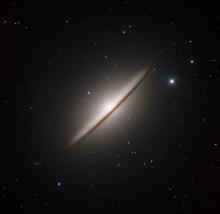Listen to today's episode of StarDate on the web the same day it airs in high-quality streaming audio without any extra ads or announcements. Choose a $8 one-month pass, or listen every day for a year for just $30.
You are here
Hunting ‘Little’ Quasars
The early universe was dark. The first stars and galaxies were embedded in a “fog” of atoms with no charge. By a billion years after the Big Bang, though, the fog was gone. The atoms had been “reionized” — charged up by something.
Much of the energy probably was provided by hot, massive stars. But some of it could have come from quasars — disks of superhot gas around supermassive black holes at the hearts of galaxies.
The biggest quasars are some of the brightest objects in the universe. Their black holes are billions of times the mass of the Sun, and they’re pulling in huge amounts of gas. But they’re rare — there just aren’t enough of them to reionize the universe.
So an astronomer at the University of Texas is looking to see if less-powerful quasars — powered by black holes perhaps a few million times the Sun’s mass — could have helped out.
Steven Finkelstein is using observations from the Hobby-Eberly Telescope Dark Energy Experiment. It uses a telescope at McDonald Observatory to study dark energy. But its observations can be used for many other studies.
The experiment is looking at hundreds of thousands of galaxies from when the universe was just a few billion years old — far more galaxies from that era than astronomers have seen before. A particular wavelength of light reveals what was going on inside the galaxies. It can even reveal if they had “little” quasars — possible engines for banishing the cosmic fog.
Script by Damond Benningfield





